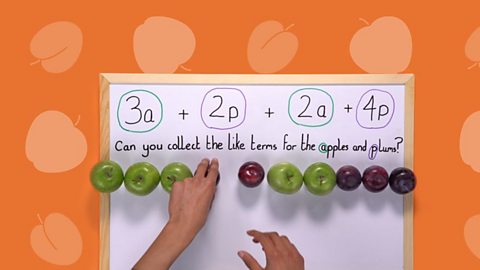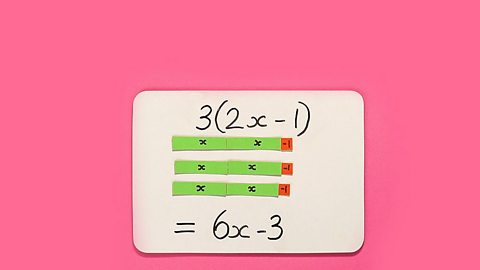Understanding terms and expressions
In algebra, letters are used when numbers are not known.
Algebraic terms, such as \(2s\) or \(8y\), leave the multiplication signs out.
So rather than \(2 \times s\), write \(2s\), and rather than \(8 \times y\) write \(8y\).
The number must always be written before the letter, for example, \(4a\) rather than \(a4\).
A string of numbers and letters joined together by mathematical operations such as \(+\) and \(-\) is called an algebraic expression, for example \(r + 2s\).
Question
Suppose that \({g}\) is the cost of child admission and \({k}\) is the cost of adult admission to the zoo:
The Khan family visit the zoo - they have \({3}\) adults and \({3}\) children.
They will need \({3}\) adult tickets and \({3}\) child tickets.
The cost for \({3}\) adults is \(3k\) and the cost for 3 children is \(3g\).
The total cost for the Khan family can be written by the expression \(3k + 3g\).
Write an algebraic expression for the cost for the Norman family of \({5}\) children and \({4}\) adults to visit the zoo.
Answer
\(5g + 4k\)
Adding and subtracting like terms
Algebraic terms that have the same letter are called like terms.
Only like terms can be added or subtracted.
\(9b\), \(-7b\) and \(13b\) are like terms, but \(6t\), \(5x\) and \(-11z\) are not like terms.
When like terms are added and subtracted, it is called simplifying.
Example
The Khan family and the Norman family visit the zoo together - there are \({8}\) children and \({7}\) adults in the group.
Because there are more than \({10}\) people, the families can take advantage of a special offer - \({1}\) child can be admitted free of charge.
As before if we use \({g}\) for the cost of child admission and \({k}\) for the cost of adult admission, then:
Cost for the Khan family \(= 3g + 3k\)
Cost for the Norman family \(= 5g + 4k\)
Offer \(= - g\)
Total cost \(= 3g + 3k + 5g + 4k - g\)
Simplified \(= 3g + 5g - g + 3k + 4k = 7g + 7k\).
+ and - signs
A term, like a number, belongs with the sign that sits in front of it.
So in the expression \(2k - g\), the \(g\) belongs with the \(-\) sign that sits in front of it, so it is \(- g\).
If the first term in an expression has no sign in front of it then it is positive.
There is no sign in front of \(2k\) - therefore it is positive.
Example: + and - signs
Collect all the like terms together for \(3g + 3k + 5g + 4k - g\).
Gathering all the \(g\)s and \(k\)s together would give \(3g + 5g - g + 3k + 4k\).
When you add or subtract terms, keep each term with their \(+\) or \(-\) sign.
Question
Simplify \(4x + y - 2x + 6y\).
Answer
Rewrite the expression by putting the like terms next to each other.
Remember to keep the \(+\) or \(-\) with the terms they belong to.
\(4x + y - 2x + 6y\)
\(= 4x - 2x + y + 6y\)
Simplify this to get:
\(2x + 7y\)
Collecting like terms
Remember that any term containing the same letter can be combined by adding and subtracting.
So: \(3g + 3k + 5g + 4k - g\)
\(= 3g + 5g - g + 3k + 4k\)
\(= 7g + 7k\)
Like terms that include powers can only be added or subtracted if the powers are the same.
Like terms with different powers cannot be added or subtracted.
Example - Collecting like terms
Simplify:
\(3x + 5 + {x}^{2} - 2x + {2x}^{2} - 1\)
Answer
Rearrange the expression so that like terms with the same powers are next to each other:
\({x}^{2} + {2x}^{2} + 3x - 2x + 5 - 1\)
And then simplify:
\({3x}^{2} + x + 4\)
We usually write the expression with the \({x}^{2}\) term first, then the \({x}\) term, and finally the number term.
Question
Simplify:
\(5 + 4x^2 - 3 + 2x + x^2 - 4x\)
To get the answer, rearrange the expression:
\(4x^2 + x^2 + 2x - 4x + 5 - 3\)
and then simplify:
\(5x^2 - 2x + 2\)
Multiplying terms and expressions
Algebraic terms and expressions can be multiplied in the same way as numbers.
\(a \times a = a^2\)
\(b \times b = b^2\) etc
Remember that \(2a\) is not the same as \(a^2\)
\(2a = 2 \times a\)
\(a^2 = a \times a\)
In general, \(a^m \times a^n = a^{(m + n)}\).
Question
Simplify:
a) \(a^2 \times a^3\)
b) \(p^4 \times p^2\)
a) \(a^2 = a \times a\) and \(a^3 = a \times a \times a\), so:
\(a^2 \times a^3 = a \times a \times a \times a \times a = a^5\)
Alternatively, using the general rule: \({a}^{2}\times{a}^{3}={a}^{(2+3)}={a}^{5}\).
b) \(p^4 \times p^2 = p^{(4 + 2)} = p^6\)
\(x\) is the same as \(x^1\).
For example, \(n^3 \times n = n^3 \times n^1 = n^{(3 + 1)} = n^4\).
Multiplying letters and numbers
Multiply letters and the numbers separately:
\(2 \times 3a\) means \(2 \times 3 \times a\) which is \(6a\).
\(4a \times 5a\) means \(4 \times a \times 5 \times a\) which is \(4 \times 5 \times a \times a = 20a^2\).
Question
Simplify \(2p \times 3p^2\).
\(2p \times 3p^2\)
\(= 2 \times p \times 3 \times p \times p\)
\(= 2 \times 3 \times p \times p \times p\)
\(= 6p^3\)
Or, an alternative method would be:
\(2 \times p \times 3 \times p^2\)
\(2 \times 3 \times p \times p^2\)
\(= 6p^3\)
Test yourself
Question 1
If \({g}\) is the cost of admission for one child to the zoo, what is the cost for \({7}\) children?
Answer
You need to multiply the number of children by the cost per child.
So, \({7}\times{g}={7}{g}\).
Question 2
A family of \({2}\) children and \({3}\) adults visit their local zoo.
\({g}\) represents the cost of admission for one child and \({k}\) represents the cost for one adult.
Write an expression for the total cost of admission for the family.
Answer
The cost per child is \({g}\) and there are \({2}\) children.
So the cost for the children will be \({2g}\).
The cost for the adults will be \({3k}\).
So the correct answer is \({2}{g}+{3}{k}\).
Question 3
Simplify \({5}{a}+{2}{b}-{a}+{b}\)
Answer
Be careful with the \(+\) and \(-\) symbols.
The correct answer is \({4}{a}+{3}{b}\).
Question 4
Simplify \({5}{x}^{2}+{3} - {2}{x}^{2} - {4}\).
Answer
Collect the like terms: \({5}{x}^{2}-{2}{x}^{2}+{3}-{4}\)
Then simplify: \({3}{x}^{2}-{1}\).
Question 5
Simplify \({6}{x}^{2}+{7}-{2}{x}-{3}{x}^{2}-{5}{x}+{1}\)
Answer
Collect the like terms: \(6x^2 – 3x^2 – 2x – 5x + 7 + 1\)
Then simplify: \(3x^2 – 7x + 8\)
Question 6
Simplify \({3}{a}\times{4}{a}{b}\)
Answer
Note that you are multiplying, so \({3}\times{4}={12}\).
\({a}\times{a}={a}^{2}\).
Therefore, the correct answer is: \({12}{a}^{2}{b}\)
Question 7
Simplify \({9}{q}^{2}\times{2}{q}^{5}\)
Answer
Note that \({q}^{2}\times{q}^{5}=({q}\times{q})+({q}\times{q}\times{q}\times{q}\times{q}) = {q}^{7}\).
\({9}\times{2} = {18}\)
The correct answer is \({18}{q}^{7}\).
More on Algebra
Find out more by working through a topic
- count4 of 29

- count5 of 29

- count6 of 29

- count7 of 29
